Robert Hooks – December 17, 2014
Per Dale Shields who chose this photo to illustrate the important principles stated below:: Robert Hooks…Sometimes… if you really look into a photograph… it speaks volumes. Teach the children. Share your stories. Pass on our history. “Each one, teach one.” {Each One Teach One is an African-American Proverb. The original author is unknown.} This phrase originated in the United States during slavery, when Africans were denied education, including learning to read.
Many, if not most slaves were kept in a state of ignorance about anything beyond their immediate circumstances which were under the control of owners, the lawmakers, and the authorities. When a slave learned or was taught to read, it became his duty to teach someone else, spawning the phrase “Each one, teach one.” In the first half of the 20th century, the phrase was applied to the work of a Christian missionary, Dr. Frank Laubach, who utilized the concept to help address poverty and illiteracy in the Philippines. Many sources cite Dr. Laubach as creating the saying, but many others believe that he simply used it in order to advance the cause of ending illiteracy in the world.
In the 1996 novel Push by Sapphire as well as the 2009 movie Precious the expression is used as the name of an alternative school that the principal character is attending after being expelled from public school.”}
*~*
HOW IT ALL STARTED…
Dear Dale… Hopefully, because you have a ready-made historical platform, you having this ‘accurate’ information might move us forward, toward correcting the persistent, misinformation of the founding of The Negro Ensemble Company.
Peace, Robert
Robert Hooks, The Negro Ensemble Company
And the Actual Sequence of His Causes
That Led to The Birth of the NEC

“The Negro Ensemble Company was fortunate in having phenomenal theatre photographer Bert Andrews on our staff. Bert insisted on composing this classic close-up of the three founders (NEC circa 1967). Left to right: Administrative Director Gerald S. Krone, Artistic Director Douglas Turner Ward, and Executive Director/Producer Robert Hooks. We wanted to create something more than just a theatre company that produced new plays, but rather a cultural institution comprised of a producing entity (presenting 4 to 5 mostly original plays per season), an acting company employing 15 top Black professional performing artists, and vibrant free training programs for actors, writers, directors, designers, and aspiring theatre administrators. With an initial three-year Ford Foundation grant of a million and a half dollars, the three of us were determined to build a new and completely autonomous theatre institution, one where we three were always in complete control of our destiny in the world of national and international theatre production and training. The immense scope and ongoing influence of the NEC can be grasped on its Wikipedia page (https://en.wikipedia.org/wiki/Negro_Ensemble_Company). Suffice it to say there is barely any TV show, film, or major theatre production from the 1960s into the present, that does not reflect talent (in front of or behind the lights) that did not pass through or be affected by the creation of the Negro Ensemble Company.”
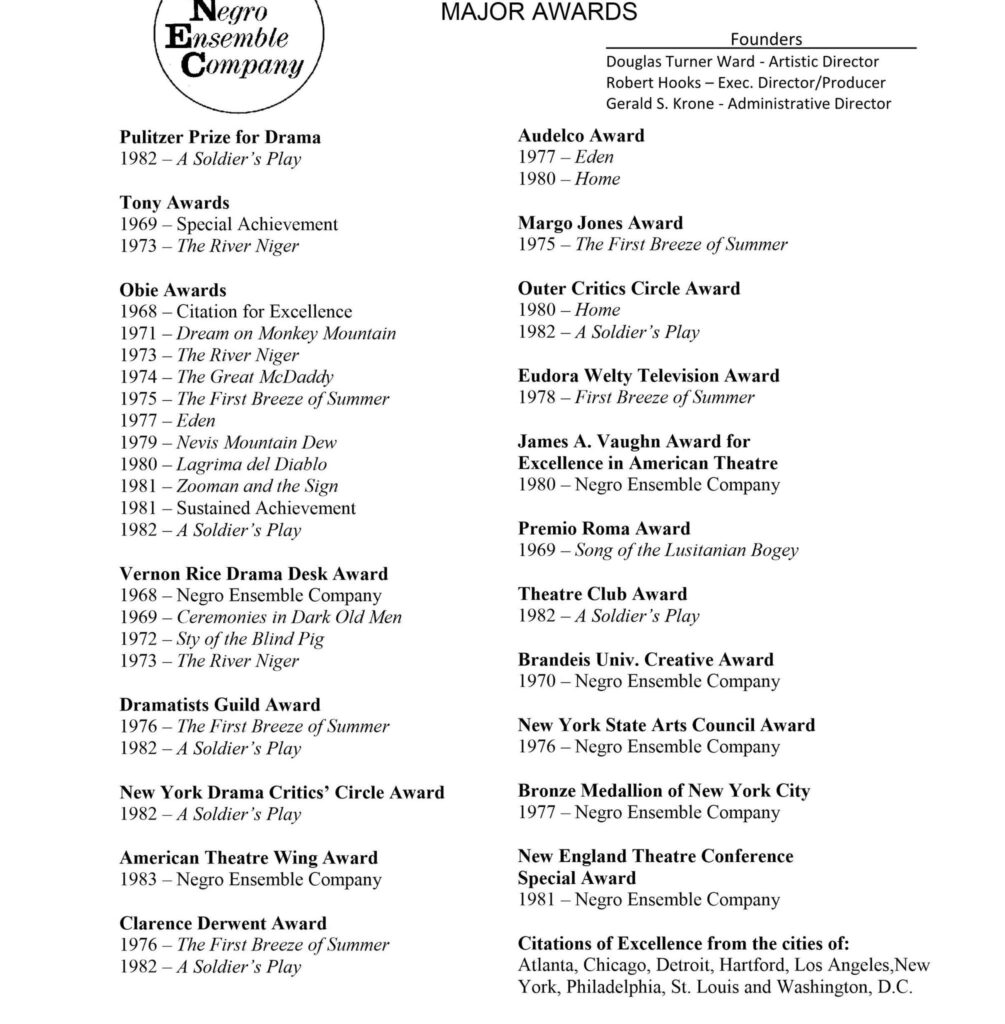
A friend asked what were some of the important theatre awards the world famous Negro Ensemble Company (NEC) had garnered over the years. Well, here’s an early list I have on hand. However, there are several more prestigious theatre Awards not included here, that were bestowed on NEC into the 21st century. Trust me, no other Black American theatre company has such a list.
While “Happy Ending” & “Day of Absence” were not produced by the NEC until the 1969-70 season, MY INDEPENDENT 1965 PRODUCTION OF THEM led to the creation of the NEC in 1967.

“A piece of important Black history… These two brilliant one-act plays were solely responsible for the creation of the world-famous Negro Ensemble Company!… And also influenced and fueled the beginning of the Black Theatre Movement in America!”
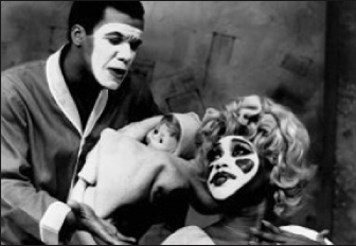
“Day of Absence“ by the late, great Douglas Turner Ward. “Absence” and its companion piece “Happy Ending” (circa 1965,) were the two plays that led to the creation of the famed Negro Ensemble Company TWO YEARS LATER. Here, in white-face, are characters John and Mary, me, and the brilliant artist Barbara Ann Teer. Happy Ending and Day of Absence left audiences howling with laughter, but definitely getting Ward’s message regarding white prejudice in America!
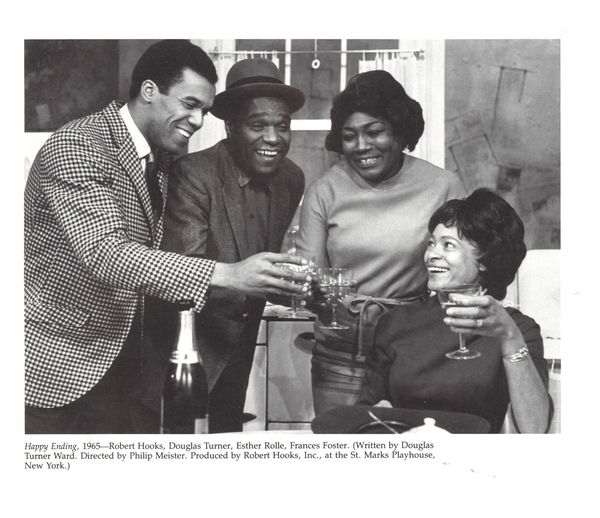
This is the play that started it all! ..The movement that is! “1965: This is from my production of “Happy Ending” (with its hilarious satirical companion play “Day of Absence”) by Douglas Turner Ward that was the true genesis for the creation – in 1967 – of the now legendary Black theatre institution The Negro Ensemble Company. The seed was planted three years before this when I created my very first theatre company – The Group Theatre Workshop (GTW, a company of young, aspiring New York actors, dancers, writers, and theatre designers) out of my Chelsea apartment where they did scene study, movement and other daily workshops. (I was soon evicted for tearing down a wall to create a stage for them!) All while I was performing in “Dutchman” at the time. In this scene from Happy Ending are Me, Douglas, Esther Rolle, and Frances Foster! An amazing beginning to a historic Black theatre movement in America!“
Robert Hooks Interviews Douglas Turner Ward for Lincoln Center Library -1987
THE SEQUENCE
In 1964 I founded The Group Theatre Workshop for young artists. I was running the classes in my apartment, so I enlisted Barbara Ann Teer to assist me. This group of sincere teens also included Hattie Winston, Antonio Fargas, and Daphne Maxwell Reed.
To assuage the curiosity of parents and neighbors regarding the activity in my apartment. In the summer of 1964, I decided to mount a one-night Monday showcase (at The Cherry Lane Theatre where I was then appearing in “Dutchman”). The evening included Gwendolyn Brooks’ “We Real Cool.” I wanted to end the evening with a play. I ask Douglas Turner if could I present his short one-act “Happy Ending” featuring my students (rounding out the evening ).
To my eternal surprise somehow Jerry Tallmer, the head theatre reviewer for the NY Post had heard about this showcase and attended the evening. He wrote a glowing review of the young students! He was very impressed with the concept and writing of the play. This gave me the impetus to persuade Douglas to allow me to get the option rights from the White producer who had been unable to raise funds to produce the two incendiaries, excoriating one-acts “Happy Ending” & “Day of Absence”.
I raised the entire budget from just two individuals – Clarence Avant and Al Bell, the founders of Stax Records – making this production THE FIRST PRODUCTION BY A BLACK AUTHOR, BLACK PRODUCER, WITH BLACK MONEY, THAT WAS EVER PRODUCED ON THE NEW YORK STAGE! (It was Juanita Poitier, Sidney’s first wife, who set me up with them.)
Due to the blazing success of MY 1965 production of both Doug’s one-acts mounted at the St. Marks Playhouse (which in 2 years would become the home of the NEC), Doug then became the next anointed Black playwright, (as I was filming Otto Preminger’s “Hurry Sundown” and continued to run the New York production office from the film location). Doug was invited by the New York Times to write an editorial for their Sunday theatre section, the brilliant article “Theatre in America – For Whites Only” (1966). That, in turn, caught the attention of the Ford Foundation’s McNeil Lowry, which prompted him to approach ‘US’ inviting us to write a proposal for “an ideal Black theatre company.”
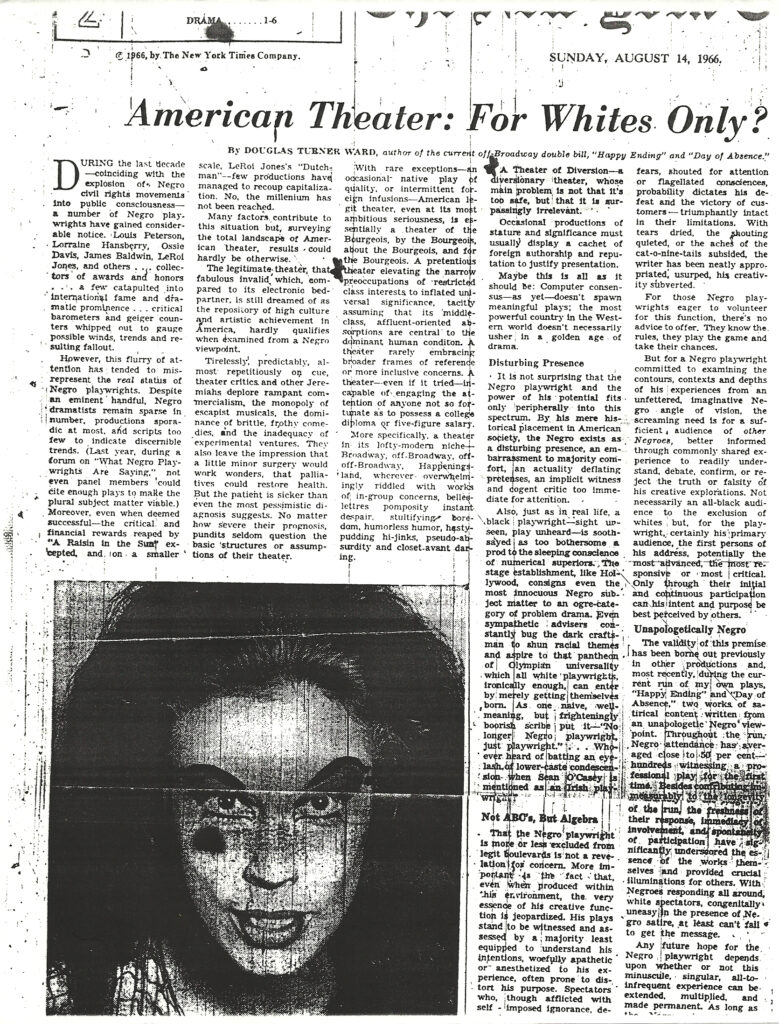
I am very proud that I presented that evening with my students in 1964, where I introduced Douglas’ Happy Ending because without the addition of his play, there would have never been reviewed.
I then assumed the role of the producer, because of Mr. Tammer’s review, presenting both one-act plays. that production turned the spotlight on The Negro Ensemble Company. My title was Executive Producer. Douglas Turner Ward was the Artistic Director. Gerald Krone was the Administrative Director.
And the three of us then produced ALL the plays from then on together as a company.
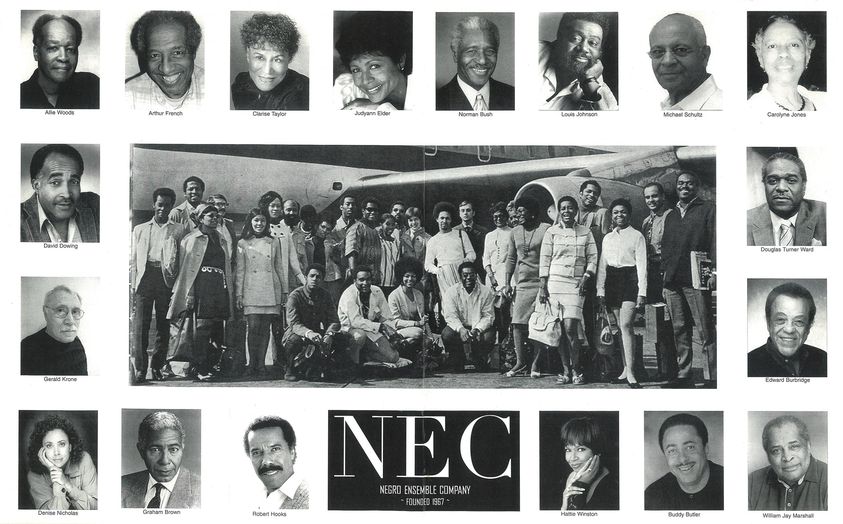
Here are the NEC artists arriving back stateside after a successful (and in the U.K. violently controversial) European and African Tour (circa 1970). One of the touring plays was the incendiary “Song of the Lusitanian Bogey” which attacked colonialism. The world theatre audiences had never seen anything like it! A momentous moment in Black world theatre history. Negro Ensemble Company – Classic
“The thinking was that there was no place in New York or anywhere else of theater for Blacks. So we wanted to create an organization where we could produce four or five plays a season and create opportunities for all these wonderful actors and playwrights and choreographers and music folk. In April 1968, I got a call from Mayor Walter Washington to come down and help the city after Dr. King was assassinated. We truly needed something after Martin was killed. We renovated an old movie house on Georgia Avenue and Emerson Streets called the Old Colony Theatre. It was just a gorgeous facility, and we had some fantastic people working with us: Debbie Allen, Glenda Dickerson, and of course, Peggy Cooper [Cafritz] and Clifford Alexander, and people like that were on board.
We were doing all original plays, but we were continually in debt. We were doing great work on stage, and the audience was coming as well. But you know, we didn’t have a full house, and the ticket prices were not high, so we couldn’t make a ton of money at the box office. The grants dried up. And I think that we just couldn’t get the support that I thought we were going to get from the Black elite. They thought the company was going to be in Southwest, down around the Arena Stage or downtown Washington. But I had no intention of doing that. I wanted the company to be in the Black community, which is where we were and were always going to be. Don’t get me wrong, we had a lot of Black support from the community. But the influential Blacks who could really help the company out financially — or at least cause the company to be more financially stable — were not to be found. And that was really one of the key reasons the company had to close.” – WASHINGTON POST [ Roxanne Roberts 2018]
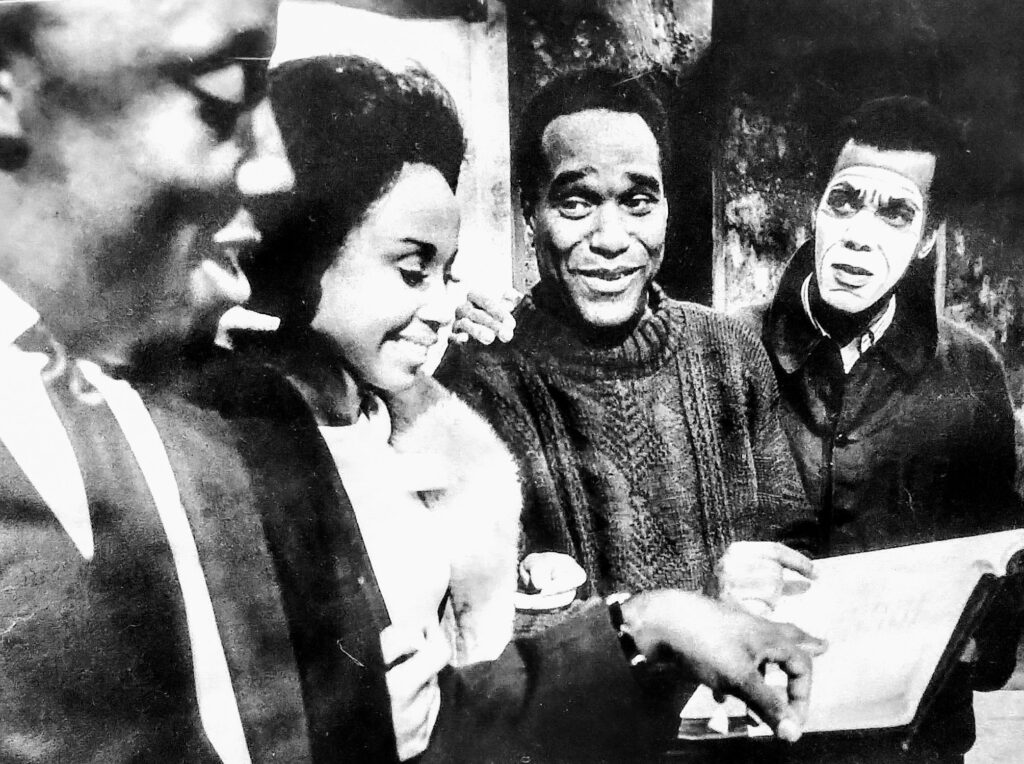
“Here’s a classic throwback photo (circa 1966)- when actor-comedian Godfrey Cambridge and lovely Broadway star Diahann Carroll visited the set of “Day of Absence”. Here, catching me and Douglas Turner Ward not quite out of our whiteface make-up. A Bert Andrews photograph was taken a year before the founding of the Negro Ensemble Company!”
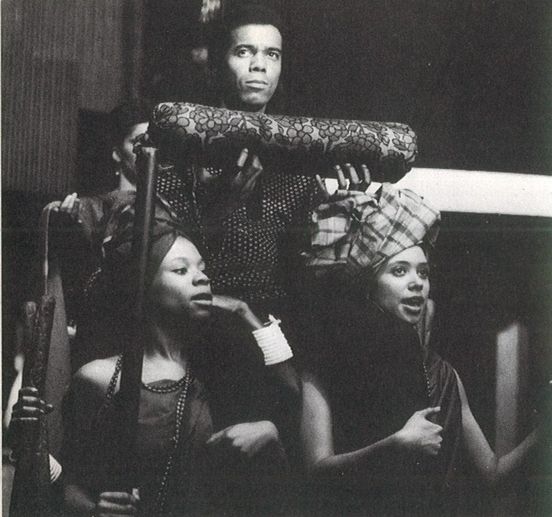
“When Douglas, Jerry, and I were finalizing the Negro Ensemble Company (NEC)’s acting company structure, I made it clear to them that I would not be acting in our productions because we were creating acting roles for other performers NOT ourselves. However, Douglas insisted I act in one of the plays in NEC’s inaugural season. He wanted me to play ‘Daoudu in Wole Soyinka’s ‘Kongi’s Harvest’, so of course, I had to say yes! And it was a fabulous experience playing this wonderful young African and working with our brilliant 15-actor permanent ensemble players. Here I am in one of the gorgeous pageantry scenes as Daoudu, together with young talented Maxine Griffith and the fabulous Denise Nicholas! Directed by Michael A. Schultz, choreography by Louis Johnson, sets by Edward Burbridge, costumes by Jeanne Button, lighting by Jules Fisher, and Music by Pat Patrick. Personally, I was honored to act aside from these amazing NEC ensemble performers! And out of all the many NEC productions, I only performed in ONE other play!”
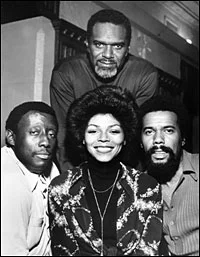 The great and bold playwright Lonne Elder, III’s powerful award-winning drama “Ceremonies in Dark Old Men” (runner-up for the 1969 Pulitzer Prize in Drama) was produced successfully in the Negro Ensemble Company’s second professional season, then was immediately picked up by ABC as a televised ABC Theatre Special. Here are four of its stars, Douglas Turner Ward (standing) and (L to R) Godfrey Cambridge, Rosalind Cash, and Me, (btw, the amazing Glynn Turman co-starred with us in this historic televised production!). ABC’s Nielsen ratings went through the roof. Also, the original production at the St. Mark’s Playhouse, home to the NEC, was directed by Edmund Cambridge (circa 1969).
The great and bold playwright Lonne Elder, III’s powerful award-winning drama “Ceremonies in Dark Old Men” (runner-up for the 1969 Pulitzer Prize in Drama) was produced successfully in the Negro Ensemble Company’s second professional season, then was immediately picked up by ABC as a televised ABC Theatre Special. Here are four of its stars, Douglas Turner Ward (standing) and (L to R) Godfrey Cambridge, Rosalind Cash, and Me, (btw, the amazing Glynn Turman co-starred with us in this historic televised production!). ABC’s Nielsen ratings went through the roof. Also, the original production at the St. Mark’s Playhouse, home to the NEC, was directed by Edmund Cambridge (circa 1969).
* HISTORY *
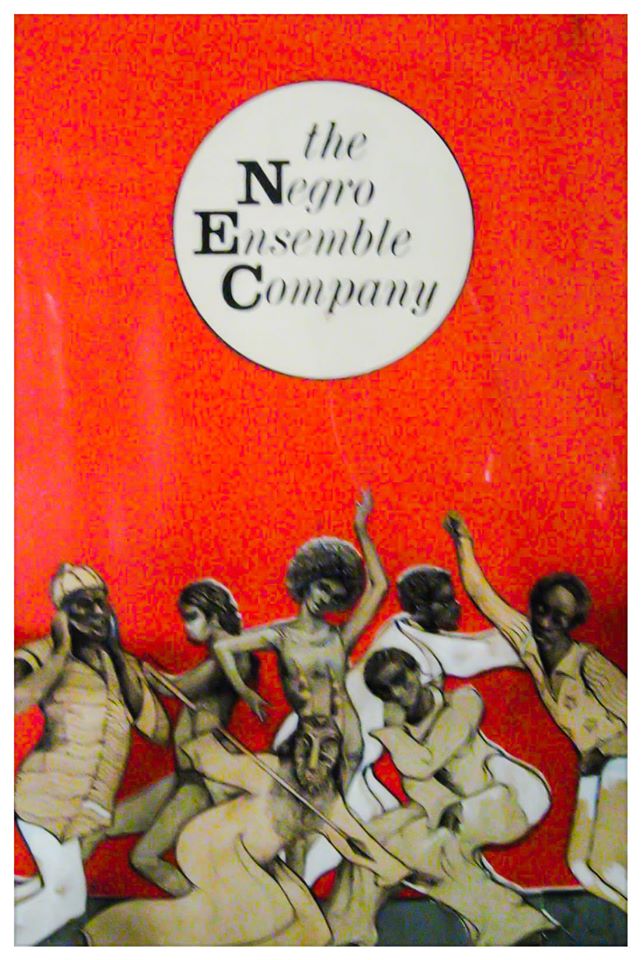
“Louis J. Delsarte, the brilliant painter, muralist, and illustrator passed away. A professor of Fine Arts at Morehouse College where he influenced so many students for futures in the fine arts. But back in 1970, when I produced a fundraising gala for the Negro Ensemble Company at New York’s Winter Garden Theatre, Louis – brought backstage by Godfrey Cambridge – surprised me with this extraordinary collage dedicated to the NEC and featuring a selection of characters from some of our major plays. It hangs in the house today, a daily reminder of this generous, true artist.”
“There was considerable controversy when the newly created Negro Ensemble Company (NEC) announced its inaugural season’s opening production, selecting white German playwright Peter Weiss’ satire “Song of the Lusitanian Bogey”! I immediately heard from a few New York artist friends: “How can the NEC call themselves a Black theatre company and open with a white writer’s work? and why call themselves “Negro” instead of “Black”?
Those questions had already been anticipated by key NEC founders (especially me), and we were more than happy to confront the controversy that arose from a small number of critics who harbored those feelings about the motives and actions of the new and promising Black arts institution. Our company title “Negro” was selected as a sincere and real homage to the artists of the Harlem Renaissance, Langston Hughes, and the other genius heroes of that historic period, who proudly called themselves Negro. We wanted “Negro” embedded in our company’s title…forever!…As to the white German playwright Peter Weiss’ brilliant play “Bogey”, we selected it because the key founders wanted NEC to be a theatre company that produced plays about the Black experience from around the world, not just here in America, it was our mission and it immediately became clear to the world, who we were!”

“Here’s a classic throwback from the inaugural season at the Negro Ensemble Company (circa 1967-68.) I’m with legendary choreographer Louis Johnson as he creates Stage Movement for our amazing ensemble actors in “Song of the Lusitanian Bogey” our very first play! Louis was with the company for decades providing brilliant choreography and mesmerizing stage movement for our productions. Louis Johnson took leave from New York’s Negro Ensemble Company (NEC) to join me at the brand new DC Black Repertory Company in my hometown of Washington (circa 1970). As we had done with the actors selected for the NEC’s permanent ensemble, these new actors, who now made up the DC Black Rep’s permanent company would need to learn (or relearn) the professional art of “stage movement” for the upcoming season. And Louis, with his brilliant and unique talent for movement for ACTORS WITHIN A DRAMATIC CONTEXT, was the only person I even considered. Some choreographers consider working with non-dancers beneath them. But Louis was a complete artist.”

After they assassinated Dr. King, riots broke out all over America, including in my hometown of Washington DC. I took a temporary leave from NEC and moved back home to help heal our fractured communities there and to start my third major theatre company, The DC Black Repertory Company. Soon after getting that underway, Doug and Jerry called and ask me to come back and put a special benefit together to help feed our dying company coffers, as our Ford Foundation grant was fading fast. I scurried (Metro railed) back to Gotham and put an ALL-STAR Benefit together, AND IT WAS JUST THAT! we raised big bucks that night, and were able to continue work at our burgeoning (and what was NOW being labeled a National Treasure) theatre institution!
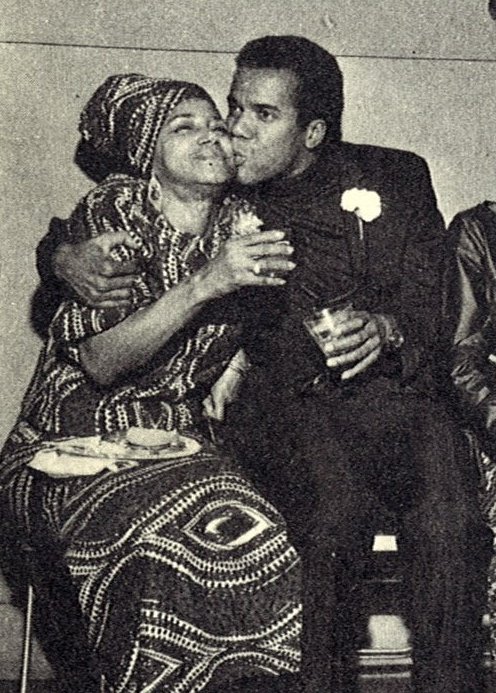
“There is nothing in theatre more pleasing than the ‘backstage celebration’ after the play’s premiere, and just before the big public splash of party glitz for the show’s success! We did a lot of this at NEC!… Seen here (in one of Bert Andrew’s surprise shots) are the brilliant NEC star Clarice Taylor smooching with NEC producer Robert Hooks (that’s me!) ..Photo was taken backstage at the “Kongi’s Harvest” opening in April 1968.”
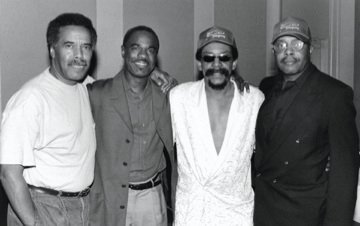
National Black Theatre Festival 1999 with Robert Hooks, Glynn Turman, Larry Leon Hamlin and Roscoe Orman

From left to right: Judyann Elder, Robert Hooks, Denise Nicholas, Arthur French, and Hattie Winston, all original members of New York’s world-famous Negro Ensemble Company. Enjoying a reunion lunch honoring Arthur French, in Los Angeles appearing in the must-see production of “The Trip to Bountiful”. Over half a lifetime of friendship in this photo! The only missing West Coast NEC original member was David Downing who, sadly, simply could not be reached for this extra special occasion. A grand and joy-filled reunion was had by all!
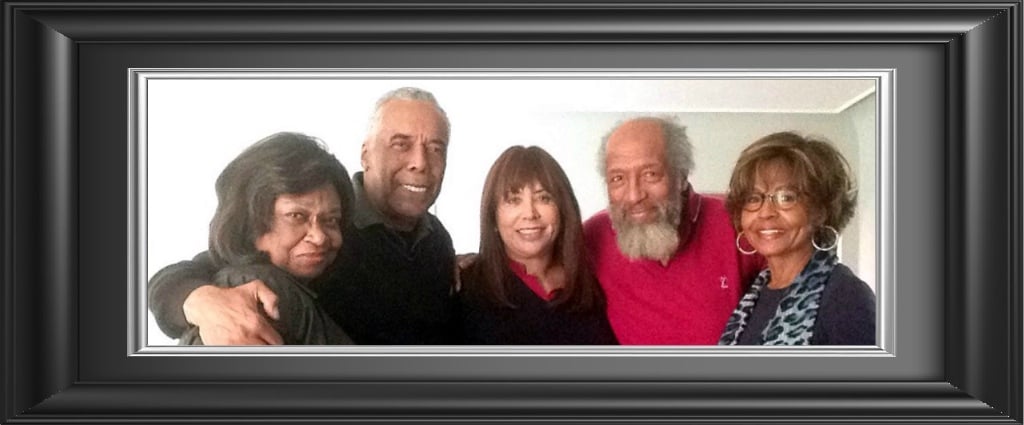
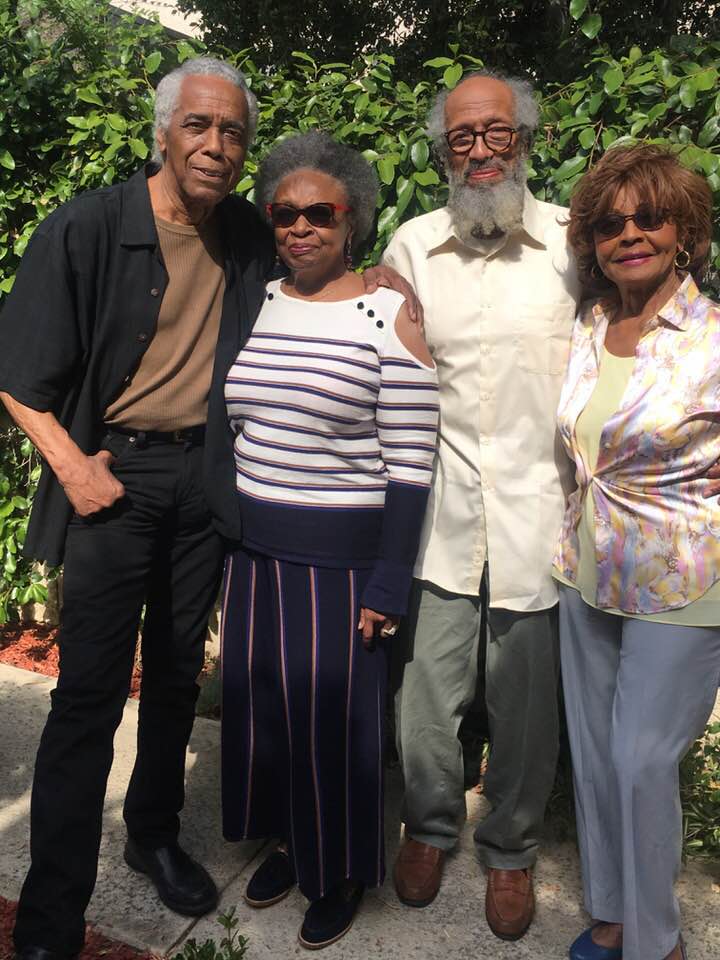
On Sunday, the day after the brilliant Arthur French was honored and celebrated by the Giving Back Corporations, Judyann, and John had an intimate gathering before he and his son, Arthur W. French III flew home to New York. Here are four original members of that national treasure, the Negro Ensemble Company – Classic, enjoying laughter, memories, and just a great good time! (from L to R) NEC founder (me), and original founding members Hattie Winston Wheeler, Arthur French, and Judyann Elder! Bravo Arthur!

After the Los Angeles tribute to the Negro Ensemble Company – Classic 50th anniversary many of my cherished NEC compatriots gathered on stage for commemorative photos. A deeply moving and meaningful experience for me. And I look forward to seeing other alums at the New York and Atlanta events to come. A powerful time indeed! — with William BT Taylor, Hattie Winston Wheeler, Judyann Elder, Luise Heath, Denise Nicholas, Chester Sims, Nancy Carter, Glynn Turman, and Ed De Shae.
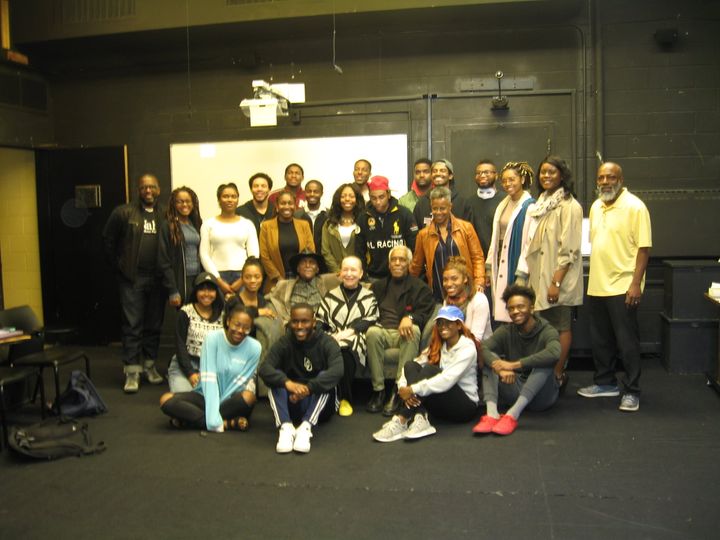
Celebrating the Negro Ensemble Company’s 50th Anniversary on tour stopping in Atlanta. Douglas and I were excited and honored to be invited to legendary Spellman College by pioneer playwright and Department professor DR. Pearl Cleage, and the Spellman Theatre Department. What a great feeling to meet these young aspiring theatre majors, and sit in wonderful discussions with them. And to really be surprised by (and thoroughly enjoy) a specially arranged and splendid staged reading of Ward’s classic satire “Day of Absence” by an awesome group of theatre students! …Here they all are (with Douglas, Pearl Cleage, and me in the middle down front. What a great welcoming for NEC’s founders’ 50th, by this excited young Spellman Theatre Department! And indeed memorable history for me and Douglas!
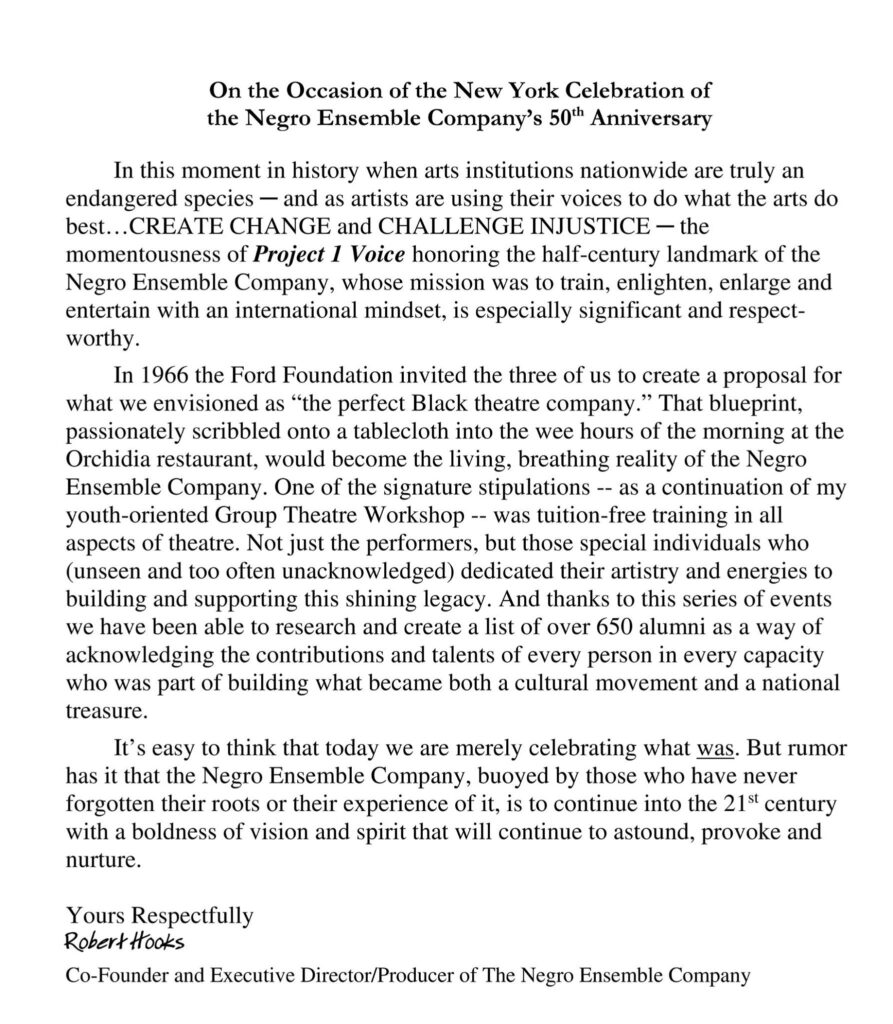
I was not at the NEC 50th New York celebration on Monday, Oct. 2nd. The following is my statement which was read at the event.
On the passing of Douglas Turner Ward [February 22, 2021]
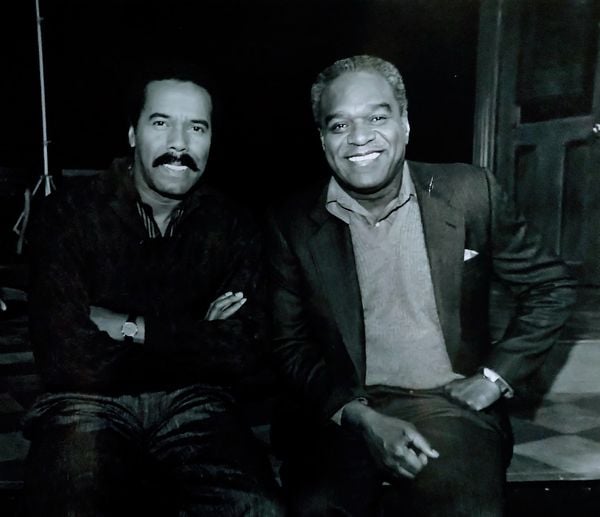
“This is LONG. But 1,000 pages wouldn’t be long enough to characterize the bond between Douglas and I. – Saturday, February 20th, 2021 was one of the saddest days in my life and is certainly a day I will never forget. It was the day I lost the best, longest, dearest friend and colleague any human could ever wish for in a lifetime. It was the day Douglas Turner Ward drew his final breath and passed on to an eternal next plane. What a long, fabulous, extraordinary, and productive friendship and cultural collaboration we enjoyed together for over 60 years.
The seeds of the lifelong friendship that would change my life and Doug’s forever begun unpropitiously. I was 21, living in Philadelphia, and studying acting at the famed Bessie V. Hicks School of Drama, hungry to master the art of acting for the stage and inhaling every creative aspect of stagecraft the school offered. The city of Philadelphia is a fabled Broadway “tryout” town, where producers open their shows in order to mold them to perfection before their actual opening on Broadway.
When the transformative play ended I was the first person to leap from my seat, applauding, bravo’ing, and yelling! I clapped so hard I broke the wrist strap on my watch and someone retrieved it from the floor for me. Couldn’t wait to go backstage. I was bursting with pride and energy! The lines outside the stars’ dressing rooms were too jammed for me to think about waiting to speak to Sidney or Ruby. Then I saw the men’s dressing room was accessible so I went in. I was able to speak with Ivan, Louis, Ed Hall, Lonne, and Douglas! It was a great conversation and they even invited me to their hotel for drinks and to just hang out and talk about acting and the play. They encouraged me to move up to New York and pursue my acting career. After seeing “Raisin” that night, and meeting those amazing and generous actors, I was ready to close out my Philadelphia life and make the move to New York. A few months later and my first professional acting job in New York was in that same play that prompted my move. Yes! ”A Raisin in the Sun”! And then, on the road with the national tour, Doug and I and Lonne became inseparable.
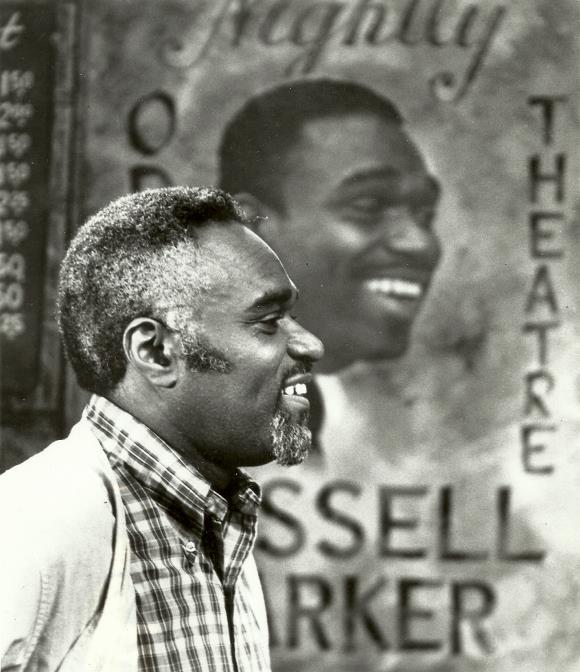
Together, Douglas and I founded the Negro Ensemble Company, a 60-year artistic and cultural collaboration that made history in the arts and changed the face and voice of theatre in America and American Black culture at that time. We also profoundly changed, grew, and evolved from each other. I LOVED …LOVE DOUGLAS TURNER WARD. And I always felt his love for me. My great and brilliant and profound friend.” – Robert Hooks
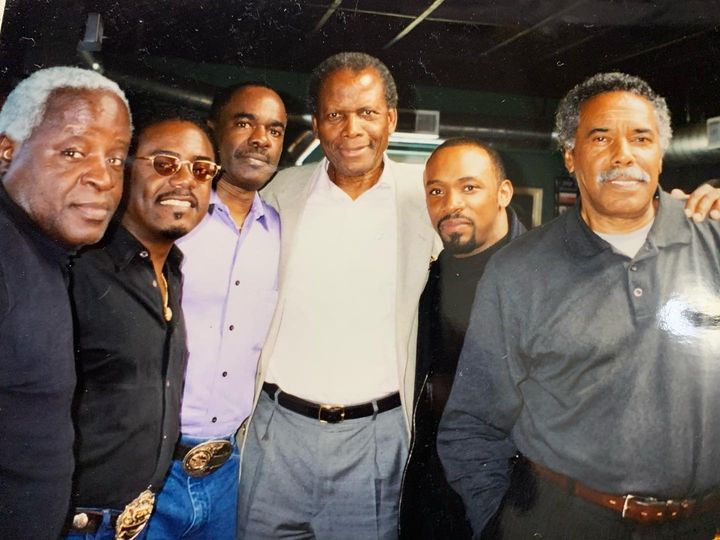
MR. ART EVANS, MR. REGINALD T. DORSEY, MR. GLENN TURMAN, MR. SIDNEY POITIER, AND MR. ROBERT HOOKS.
